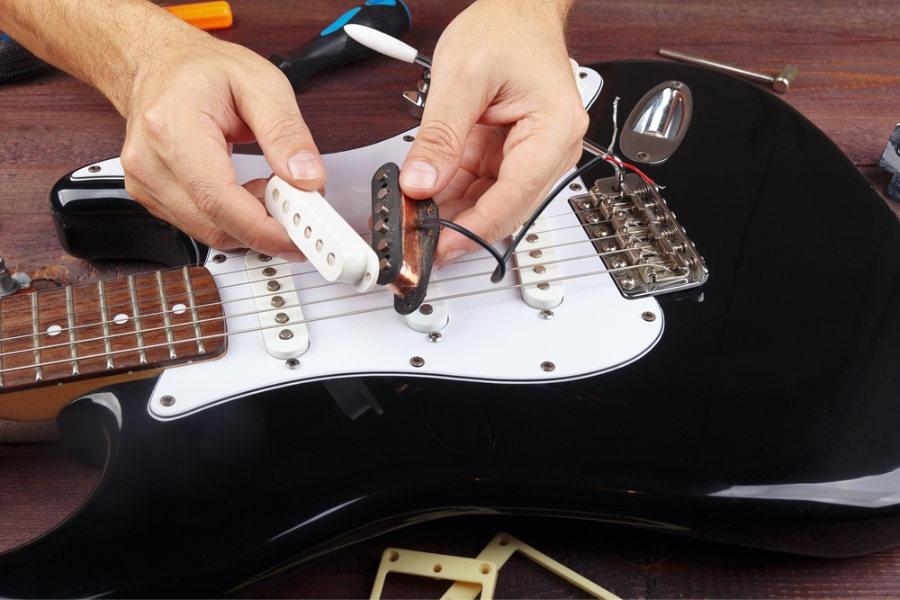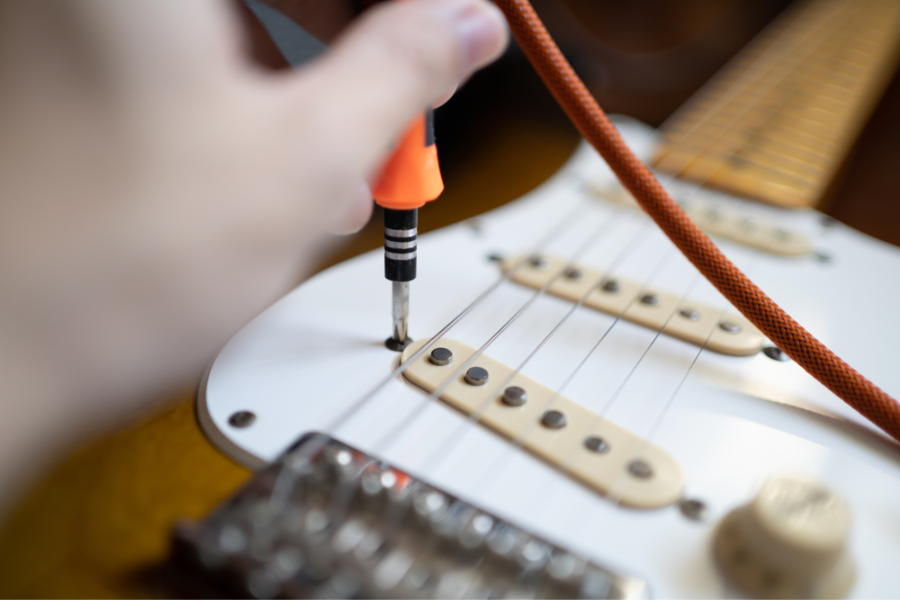Have you ever strummed a string on an electric guitar and wondered how it makes such cool sounds? Well, it’s all thanks to something called electric guitar pickups. The pickup could be said to be the “heart” of an electric guitar, it captures the movement of the strings and turns it into music. One cool fact about pickup, this device is a passive device, meaning that there is no source supplying power for it to function.
In this article, Eguitarmania will explore how these pickups catch the string’s vibes and change them into electric signals. We’re going to dive into the world of a million pickup flavors, and how do electric guitar pickups work? Read on to learn more about how the pickups affect the tone of your guitar.
What Are Pickups?
The movements of the strings are picked up by electric guitar pickups and turned into electrical messages. Modern music has a lot of different sounds that are made by amplifying and shaping these messages.

Inside a guitar pickup
At its core, a guitar pickup is a simple electromagnetic device consisting of several key components:
Magnets
These create a magnetic field that envelops the strings. Common magnet materials include: Alnico and Ceramic. Alnico magnets are popular for their balanced and warm tone, while ceramic magnets produce a stronger magnetic field than Alnico. Ceramic magnets are often used in pickups designed for rock, metal, and other high-gain styles.
Coils
Wrapped around the magnets, these coils of wire capture the vibrations of the strings. The power and tone of the pickup are affected by how many times the wire is wound around the magnet. When there are more windings, the power is higher, and the tone is softer with more middle and bass notes. Less windings mean less power, but the sound is sharper and more focused on the high frequencies.
Pole Pieces
These are magnetized points within the pickup that focus the magnetic field on specific strings, ensuring that each string’s vibration is accurately captured.
Bobbin
The bobbin serves as the framework on which the magnet(s) and coils are assembled.
Types of Pickups: Single-coil vs. Humbucker
The world of electric guitar pickups is dominated by two main types: single-coil and humbucker, each with its unique sound characteristics.
Single-coil Pickups
Their sound is known for being bright and clear. This type of pickup is usually found on Fender Stratocasters and Telecasters. It’s made up of a single coil of wire wrapped around the magnets.
However, single-coil pickups take up electromagnetic radiation, which sounds like a buzz. This hum can be heard most clearly in places with a lot of electrical noise, like near computer screens or neon lights.
Humbucker Pickups
The humbucker pickup was made to “buck the hum” that comes with single-coil designs. Two loops of wire wrapped around each other in different directions are used to do this.
This arrangement gets rid of the electromagnetic interference that single coils pick up, making the sound softer and free of the hum. They sound bigger and warmer than single coils, with less high-end sparkle and more middle presence. A lot of Gibson guitars, like the Les Paul and SG types, have them.
How Do Electric Guitar Pickups Work?
In order to understand how electric guitar pickups work, you have to look into science and electromagnetic theory. Let’s simplify electric guitar pickup science and physical theory.

The idea of electromagnetic induction is at the heart of every electric guitar pickup. According to this theory, when a circuit is put in a magnetic field that changes, an electric current flows through it. This idea is used by electric guitar pickups, which use magnets and wire coils to turn the movements of steel guitar strings into electrical messages.
An electric guitar pickup is an inductive sensor that consists, in its simplest form, of a coil wrapped around a permanently magnetic pole piece or pole pieces. This is the architecture of some of the most important and popular pickup designs, including the conventional Stratocaster pickup.
This inductive sensor sits below a string made out of a magnetic metal. When the string vibrates, a signal is generated in the coil. It is this signal that gets amplified to create the sound of an electric guitar.
This interpretation is centered on the string itself as a magnet. The magnetic field of the pickup magnetizes the string in the region above the pole piece. When the string vibrates, it becomes a source of magnetic flux, essentially a magnet moving in the vicinity of the coil.
In this model, the coil is simply a receiver of the magnetic flux being generated by the moving magnetized portion of the string.
These are two fundamentally different mechanisms of signal generation. In the first, the important part of the equation is the magnetic field of the pickup, and it’s the movement of the pickup’s own field lines that create the signal.
The second mechanism, where the string itself is a vibrating magnet, doesn’t really require that the pickup has a magnetic field of its own at all, as long as the string is magnetized.
Why Do Different Pickups Produce Different Tones?
Different pickups produce different tones due to their materials, construction, and the way they interact with guitar strings.
How Different Pickups Influence Genre, Playing Style, And Personal Expression.
My choice of pickups has been a critical factor in defining my sound and how I connect with different musical genres. For example, single-coil pickups, with their bright and sharp clarity, are a perfect match for genres that require distinct articulation, such as country, funk, and surf rock.

Conversely, humbuckers, with their rich and warm output, suit genres like rock, jazz, and blues, where a fuller sound with less interference is desirable.
Moreover, the pickup choice can complement a guitarist’s playing style. It’s fascinating how changing something as simple as a pickup can open up new avenues of musical exploration and identity.
Examples Of Famous Guitarists And Their Pickup Choices.
The link between pickups and musical expression is perhaps best illustrated by looking at famous guitarists and their preferences:
- Slash: The Guns N’ Roses guitarist is synonymous with the Les Paul, equipped with humbucker pickups. These pickups contribute to Slash’s thick, sustained tones that define many of the band’s hits.
- John Mayer: A modern blues and pop icon, Mayer often uses guitars with single-coil pickups for their clean, articulate sound, demonstrating the pickups’ versatility across genres.
- Jimi Hendrix: Known for his revolutionary guitar playing, Hendrix mainly used single-coil pickups on his Fender Stratocasters. This choice contributed to his iconic, crisp, and clear tone, which was revolutionary in the rock genre.
Do Pickups Need Maintenance?
Like any part of a musical instrument, pickups do need maintenance. Let’s discuss cleaning and care tips, and identifying signs that your pickups might need attention or replacement.
Cleaning and care tips for pickups.
Regular Cleaning
Use a soft brush or compressed air to gently remove dust
Regularly wiping down your pickups with a dry, soft cloth can prevent build-up.
Use a cotton swab lightly moistened with isopropyl alcohol to clean around the pole pieces.
Dry immediately with another clean cloth to prevent any moisture damage.

Checking and maintenance
Apply a thin layer of protective oil (like lemon oil) to metal parts to prevent corrosion.
Carefully remove any excess wax with a plastic tool and clean the area with a soft cloth.
Plug in your guitar and test the pickups by playing, checking for any changes in sound quality
Eguitarmania’s Tips: Schedule regular cleaning sessions : A quick dust-off every 3–6 months is a good practice for most players.
Signs That Your Pickups Might Need Attention Or Replacement.
Simple cleaning and care, along with periodic checks for signs of wear or damage, can prolong the life of your pickups and ensure your guitar sounds its best.
| Sign | Possible Cause | Suggested Action |
| Loss of Output | Damaged coil, disconnected wire | Check connections, consider replacement |
| Intermittent Sound | Loose/corroded connections | Tighten connections, clean corrosion |
| Change in Tone | Pickup degradation | Evaluate for replacement |
| Physical Damage | Impact, moisture, corrosion | Assess for repair or replacement |
| Excessive Hum/Noise | Grounding issue, coil failure | Inspect wiring, possibly replace pickup |
Final Thought
In conclusion, each type of pickup has its own sound that can be adapted to any artistic style or personal expression. Not only does knowing how pickups work make us appreciate the electric guitar more, but it also gives us the power to make smart decisions as we search for the right tone.









